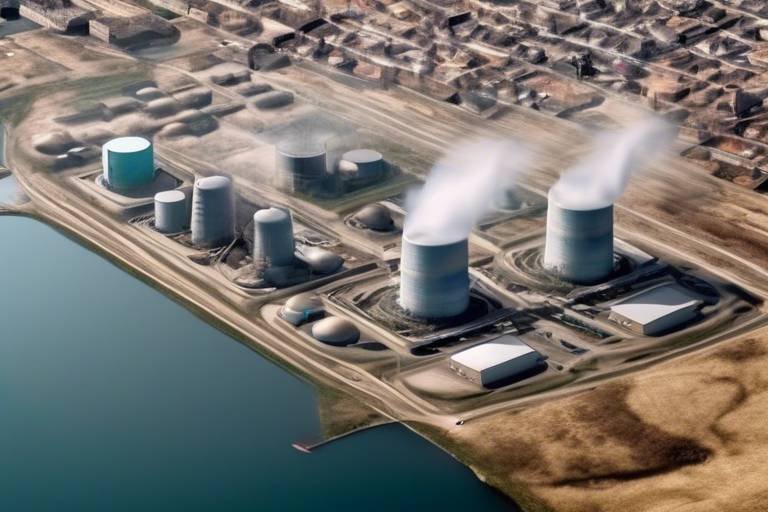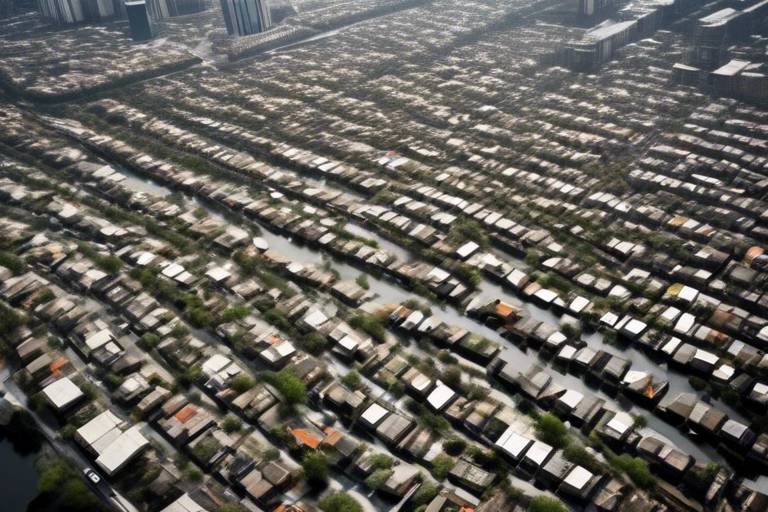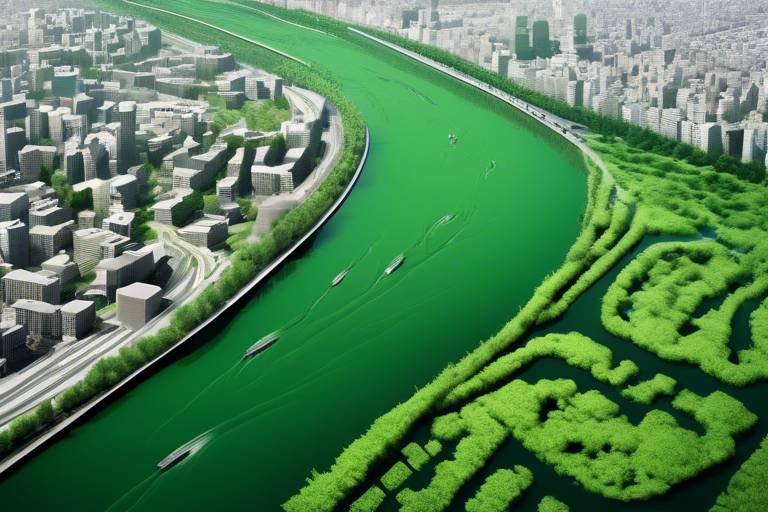Is Geo-Thermal Energy Suitable for Urban Sustainability?
As cities around the globe grapple with the pressing challenges of climate change and urbanization, the question of sustainable energy solutions becomes increasingly critical. One of the most promising candidates in the renewable energy sector is geothermal energy. But is it truly suitable for urban sustainability? This article dives deep into the potential of geothermal energy in urban settings, examining its myriad benefits, the challenges it faces, and its overall suitability for fostering sustainable development in our bustling cities.
Geothermal energy is derived from the natural heat stored within the Earth, originating from the planet's core. This energy source is not only renewable but also incredibly efficient. It can be harnessed in various forms, including geothermal power plants, which convert steam or hot water from the Earth's interior into electricity, and geothermal heat pumps, which utilize the stable temperatures beneath the Earth's surface for heating and cooling buildings. In urban environments, where space is often at a premium, the compact nature of geothermal systems can be a significant advantage, allowing cities to tap into this resource without extensive land use.
When we talk about the benefits of geothermal energy, we're looking at a treasure trove of advantages that can significantly contribute to urban sustainability. For starters, geothermal energy boasts a remarkably low carbon footprint. Unlike fossil fuels, which belch out greenhouse gases, geothermal systems emit minimal emissions, making them a cleaner alternative. Additionally, geothermal energy is highly reliable, providing a consistent energy supply that isn't subject to the whims of weather, unlike solar or wind energy. This reliability is crucial for urban areas that require a stable energy supply to support their infrastructure and growing populations.
The environmental benefits of geothermal energy are profound. By harnessing this natural resource, cities can significantly reduce their reliance on fossil fuels, leading to a marked decrease in urban pollution levels. The potential for geothermal energy to contribute to cleaner air and a healthier urban environment cannot be overstated. Imagine a city where the air is fresh, and the streets are free from the haze of pollution. This is not just a dream; it's a possibility with the adoption of geothermal systems.
Utilizing geothermal energy can greatly reduce greenhouse gas emissions, a critical factor in combating climate change. Cities that adopt geothermal energy can align themselves with global climate goals, cutting down on their carbon emissions significantly. For instance, a study found that cities implementing geothermal systems could reduce their greenhouse gas emissions by up to 50%. This drastic reduction not only helps in meeting regulatory standards but also improves the overall quality of life for urban residents.
However, integrating geothermal systems into urban environments does require thoughtful land use planning. Geothermal systems often need specific geological conditions to be effective, which can limit their implementation in certain areas. Nevertheless, with careful planning and innovative engineering solutions, cities can successfully incorporate geothermal energy without compromising valuable urban space. The key is to balance the need for clean energy with the constraints of urban development.
The economic aspects of geothermal energy are crucial for urban implementation. While the initial investment in geothermal systems can be significant, the long-term savings associated with reduced energy costs make it a financially viable option. Many cities have reported that geothermal energy can lead to savings of up to 30% on energy bills over time. Additionally, the creation of local jobs in the installation and maintenance of geothermal systems can provide an economic boost to urban areas, fostering both sustainability and economic growth.
Despite its many benefits, geothermal energy faces several challenges in urban settings. These hurdles can be technical, financial, and regulatory, and addressing them is essential for successful adoption. One of the primary technical limitations is the suitability of sites for geothermal systems. Not every urban area has the necessary geological conditions to support geothermal energy production, which can complicate implementation.
Geothermal systems can encounter various technical challenges, such as resource availability and the need for specialized drilling techniques. Urban planners must work closely with geologists and engineers to identify suitable locations for geothermal systems. Innovative technologies, such as enhanced geothermal systems (EGS), are being developed to overcome these limitations, allowing for geothermal energy extraction in a wider range of locations.
Navigating the regulatory landscape can also be a complex endeavor for geothermal projects. Cities must grapple with various legal and policy challenges, including permitting processes and compliance with environmental regulations. Streamlining these processes and creating supportive policies can help facilitate the adoption of geothermal energy in urban areas, ensuring that cities can harness this sustainable resource effectively.
- What is geothermal energy? Geothermal energy is the heat that comes from the Earth's core, which can be used for heating and electricity generation.
- How does geothermal energy benefit urban areas? It provides a renewable energy source that reduces greenhouse gas emissions, lowers energy costs, and supports economic growth.
- Are there any challenges to implementing geothermal energy? Yes, challenges include technical limitations, regulatory barriers, and the need for site suitability assessments.

Understanding Geothermal Energy
Geothermal energy is a fascinating and powerful renewable energy source that taps into the natural heat stored beneath the Earth's surface. Imagine the Earth as a giant battery, continuously generating heat from its core, which can be harnessed for various applications. This energy originates from two main sources: the residual heat from the planet's formation and the heat produced by the decay of radioactive materials within the Earth. The beauty of geothermal energy lies in its ability to provide a constant and reliable energy source, unlike solar or wind energy, which can be intermittent.
There are several types of geothermal energy systems, each suited for different uses. The most common categorization includes:
- Geothermal Power Plants: These facilities convert hydrothermal fluids—hot water or steam from the Earth—into electricity. They can be further classified into three types: dry steam, flash steam, and binary cycle plants, each utilizing different technologies to generate power.
- Geothermal Heat Pumps: These systems are designed for residential and commercial heating and cooling. They use the stable temperatures found a few feet below the surface to regulate indoor climates efficiently.
- Direct Use Applications: This involves using hot water directly from geothermal sources for applications such as heating buildings, growing plants in greenhouses, drying crops, and even in industrial processes.
In urban environments, the application of geothermal energy can be particularly transformative. Cities, often characterized by high energy demands and significant carbon footprints, can leverage geothermal systems to reduce reliance on fossil fuels. This not only aligns with sustainability goals but also enhances energy security. For instance, urban areas can utilize geothermal heat pumps for heating and cooling, significantly cutting down on energy costs while minimizing environmental impact.
However, the integration of geothermal energy into urban planning requires careful consideration. Factors such as geological conditions, existing infrastructure, and local regulations play critical roles in determining the feasibility of geothermal projects. Cities need to conduct thorough assessments to identify suitable sites for geothermal installations, ensuring that the energy harnessed is both efficient and sustainable.
In summary, geothermal energy is a promising solution for urban sustainability. By understanding its origins, types, and applications, cities can strategically implement this resource to create a more sustainable and resilient urban environment.

Benefits of Geothermal Energy
Geothermal energy is not just a buzzword; it’s a game-changer for urban sustainability. Imagine harnessing the natural heat from the Earth’s core to power your home, heat your water, and even cool your buildings! This renewable energy source is gaining traction in cities around the globe, and for good reason. The benefits of geothermal energy are numerous, making it a compelling option for urban planners and residents alike.
One of the standout advantages of geothermal energy is its low emissions. Unlike fossil fuels, geothermal systems produce minimal greenhouse gases, making them a cleaner alternative. This is particularly vital in urban areas where air quality is often compromised by pollution. By reducing reliance on coal and gas, cities can take significant strides toward cleaner air and healthier communities.
In addition to being environmentally friendly, geothermal energy is also incredibly reliable. Unlike solar or wind energy, which can be intermittent depending on weather conditions, geothermal energy provides a steady and consistent power supply. This reliability can be a lifesaver for urban areas that require a stable energy source to support their infrastructure and growing populations. Furthermore, geothermal systems can operate year-round, ensuring that heating and cooling needs are met regardless of external temperatures.
Cost-effectiveness is another significant benefit. While the initial investment in geothermal infrastructure may seem daunting, the long-term savings can be substantial. According to various studies, geothermal systems can reduce energy bills by up to 50%. This is particularly appealing for city governments and businesses looking to cut costs without compromising on energy quality. Plus, with the rising costs of fossil fuels, the economic argument for geothermal energy becomes even more compelling.
To illustrate the potential savings, consider the following table that compares the average costs of different energy sources:
| Energy Source | Average Cost per kWh | Estimated Savings with Geothermal |
|---|---|---|
| Natural Gas | $0.10 | 50% |
| Coal | $0.12 | 50% |
| Geothermal | $0.05 | N/A |
| Solar | $0.08 | 30% |
Furthermore, geothermal energy contributes to urban sustainability by promoting energy independence. Cities that invest in geothermal systems can reduce their dependence on imported fuels, which not only enhances energy security but also stabilizes local economies. By utilizing locally sourced energy, cities can keep funds circulating within the community, fostering economic growth and resilience.
When we talk about urban sustainability, we cannot overlook the importance of job creation. The geothermal sector has the potential to create numerous jobs in installation, maintenance, and operation of geothermal systems. This creates opportunities for local workers and can stimulate the economy, making it a win-win situation for cities looking to improve their sustainability credentials.
In summary, the benefits of geothermal energy are substantial and multifaceted. From reducing emissions and ensuring reliability to offering cost savings and promoting energy independence, geothermal energy stands out as a viable solution for urban sustainability. As cities continue to grapple with the challenges of climate change and energy demands, embracing geothermal energy could very well be the path forward. Are you ready to explore the potential of geothermal energy in your city?
- What is geothermal energy? Geothermal energy is heat that comes from the sub-surface of the earth. It is contained in the rocks and fluids beneath the earth's crust and can be found as far down to the hot molten rock, magma.
- How is geothermal energy used in urban areas? Geothermal energy can be used for heating buildings, generating electricity, and providing hot water. It can also be utilized for district heating systems.
- What are the environmental impacts of geothermal energy? Geothermal energy has a low carbon footprint and can significantly reduce greenhouse gas emissions compared to fossil fuels.
- Are there any downsides to geothermal energy? While geothermal energy offers many benefits, it can face challenges such as site suitability and regulatory hurdles.

Environmental Impact
When we think about energy sources that can help our planet, geothermal energy often flies under the radar. But let me tell you, this renewable energy powerhouse has a lot to offer, especially when it comes to urban environments. By tapping into the natural heat stored beneath our feet, cities can significantly reduce their reliance on fossil fuels. Imagine a world where the warmth from the Earth not only powers our homes but also keeps our air cleaner and our cities greener!
One of the most compelling aspects of geothermal energy is its minimal carbon footprint. Unlike traditional energy sources that spew harmful emissions into the atmosphere, geothermal systems operate with remarkably low emissions. According to various studies, geothermal power plants emit about one-tenth of the carbon dioxide produced by coal-fired plants. This means that by integrating geothermal energy into urban infrastructures, cities can take a giant leap towards achieving their climate goals. It’s like discovering a secret weapon in the fight against climate change!
Moreover, the potential for geothermal energy to reduce urban pollution levels is staggering. As urban populations grow, so do the challenges of air quality and pollution. By shifting towards geothermal energy, cities can tackle these issues head-on. Not only does this energy source produce fewer emissions, but it also minimizes other pollutants that contribute to smog and health problems. Picture this: a city where children can play outside without fear of inhaling toxic fumes—sounds like a dream, right? Well, geothermal energy can help make that dream a reality.
Now, let's talk about one of the biggest environmental benefits of geothermal energy: the reduction of greenhouse gases. Utilizing geothermal energy can lead to a significant decrease in emissions that contribute to global warming. Here’s how it works:
| Energy Source | CO2 Emissions (g/kWh) |
|---|---|
| Coal | 900 |
| Natural Gas | 400 |
| Geothermal | 10 |
As you can see from the table, geothermal energy stands out as an incredibly clean option. This is crucial for cities aiming to meet stringent climate targets. By adopting geothermal systems, urban areas can not only cut down on their greenhouse gas emissions but also create a healthier environment for their residents.
However, it’s essential to consider the land use considerations that come with geothermal energy systems. While geothermal plants have a smaller land footprint compared to solar farms or wind turbines, cities still need to plan carefully to integrate these systems without disrupting urban space. This means that urban planners must work hand-in-hand with energy experts to identify suitable locations for geothermal installations, ensuring that they don’t interfere with existing infrastructure or green spaces.
In conclusion, the environmental impact of geothermal energy is nothing short of impressive. From its low emissions and ability to reduce pollution to its role in curbing greenhouse gases, geothermal energy presents a golden opportunity for urban sustainability. As cities continue to grapple with the challenges of climate change and urbanization, embracing geothermal energy could be the key to creating cleaner, healthier, and more sustainable urban landscapes.
- What is geothermal energy? Geothermal energy is the heat that comes from the Earth's core, which can be harnessed for electricity and heating.
- How does geothermal energy impact the environment? It has a minimal carbon footprint, produces low emissions, and can help reduce urban pollution levels.
- Are there any challenges to implementing geothermal energy in cities? Yes, there are technical, financial, and regulatory hurdles that must be addressed for successful adoption.

Reduction of Greenhouse Gases
In today’s world, where climate change looms over us like a dark cloud, the urgency to reduce greenhouse gas emissions has never been more critical. Geothermal energy emerges as a beacon of hope in this battle against climate change. By tapping into the Earth's natural heat, cities can significantly lower their carbon footprints, transforming their energy consumption patterns in the process.
One of the most compelling aspects of geothermal energy is its potential to replace traditional fossil fuels, which are notorious for their high greenhouse gas emissions. When cities invest in geothermal systems, they are not just adopting a new energy source; they are making a statement about their commitment to sustainability. Imagine a city where the air is cleaner, the skies are bluer, and the overall quality of life is improved. This is the promise that geothermal energy holds.
To put things into perspective, let’s consider the numbers. According to research, geothermal energy can reduce carbon dioxide emissions by up to 90% compared to coal-fired power plants. This is a staggering reduction that can lead to significant improvements in urban air quality. Here’s a simple comparison:
| Energy Source | CO2 Emissions (per MWh) |
|---|---|
| Coal | 900 kg |
| Natural Gas | 400 kg |
| Geothermal | 50 kg |
This table illustrates the stark difference in emissions between various energy sources. As you can see, geothermal energy stands out as a cleaner alternative. But it’s not just about numbers; it’s about creating a sustainable future for urban populations. By reducing greenhouse gas emissions, cities can work towards meeting their climate goals, contributing to global efforts to combat climate change.
Moreover, the integration of geothermal energy can also lead to a ripple effect in urban planning and policies. As cities adopt cleaner energy solutions, they can encourage green building practices and promote sustainable transportation options, further enhancing their environmental impact. This interconnected approach can create a holistic strategy for sustainability, where every initiative complements the others, leading to a more resilient urban ecosystem.
In conclusion, the reduction of greenhouse gases through geothermal energy is not merely an environmental necessity; it’s a transformative opportunity for cities. By embracing this renewable energy source, urban areas can pave the way for a cleaner, healthier future. So, why not take the leap and invest in geothermal solutions? The benefits are clear, and the time to act is now.

Land Use Considerations
When it comes to integrating geothermal energy into urban environments, land use considerations play a pivotal role. Cities are often bustling with activity, and every square meter is precious. Thus, the challenge lies in how to effectively utilize geothermal resources without compromising the limited space available. Unlike traditional energy sources, which may require vast areas for infrastructure, geothermal systems can be designed to occupy smaller footprints, making them particularly appealing for urban settings.
One of the most significant benefits of geothermal energy is its ability to be implemented in a variety of settings. For instance, district heating systems can serve multiple buildings from a central geothermal source, optimizing space usage while providing heat efficiently. This not only reduces the need for individual heating systems but also minimizes the environmental impact associated with traditional heating methods.
However, careful planning is essential. Urban planners must consider factors such as:
- Proximity to geothermal resources: Identifying suitable sites that are close to geothermal reservoirs is crucial. This can often dictate the feasibility of a geothermal project.
- Integration with existing infrastructure: It's important to assess how geothermal systems can be integrated with current urban infrastructure, such as roads, buildings, and utilities.
- Community acceptance: Engaging with local communities to address concerns and gain support is vital for the successful implementation of geothermal energy projects.
Moreover, cities must also evaluate the long-term implications of land use for geothermal systems. As urban areas continue to expand, the potential for land conflicts increases. Therefore, it’s essential to develop a comprehensive strategy that includes zoning regulations and land use policies that support geothermal energy development while protecting other land uses.
In summary, while the adoption of geothermal energy in urban settings presents unique challenges related to land use, it also offers a promising avenue for sustainable energy. The key lies in innovative planning and community engagement, ensuring that urban spaces can evolve to meet the energy needs of the future without sacrificing their integrity.
1. What is geothermal energy?
Geothermal energy is the heat that comes from the Earth's core, which can be harnessed for various applications, including electricity generation and heating.
2. How is geothermal energy used in urban areas?
In urban settings, geothermal energy can be utilized for district heating systems, hot water supply, and even for cooling purposes in buildings.
3. What are the environmental benefits of geothermal energy?
Geothermal energy has a minimal carbon footprint and can significantly reduce greenhouse gas emissions, contributing to cleaner air and a healthier environment.
4. What challenges does geothermal energy face in urban areas?
Challenges include technical limitations such as site suitability, regulatory barriers, and the need for significant upfront investment.
5. How can cities overcome land use challenges for geothermal projects?
Cities can develop comprehensive land use strategies, engage with communities, and create zoning regulations that facilitate the integration of geothermal energy while protecting urban space.

Economic Viability
When it comes to the of geothermal energy in urban settings, the numbers tell a compelling story. Imagine a world where cities run efficiently on a renewable resource that not only saves money but also promotes sustainability. Geothermal energy is that resource, offering a unique blend of benefits that can significantly impact urban economies. One of the most appealing aspects is its cost-effectiveness. Once the initial investment is made, the operational costs of geothermal systems are relatively low compared to traditional energy sources. This is largely because geothermal plants have low maintenance costs and can operate continuously, unlike solar or wind energy that depends on weather conditions.
Moreover, geothermal energy systems can provide long-term savings. According to various studies, the average payback period for geothermal installations can range from 5 to 10 years, depending on the local energy prices and installation costs. After this period, the savings on energy bills can be substantial, leading to a significant return on investment. To illustrate this, consider the following table that outlines the potential savings over time:
| Year | Energy Costs (Traditional) | Energy Costs (Geothermal) | Savings |
|---|---|---|---|
| 1 | $1,200 | $800 | $400 |
| 5 | $6,000 | $4,000 | $2,000 |
| 10 | $12,000 | $8,000 | $4,000 |
Another critical factor in the economic viability of geothermal energy is its potential to create jobs. The installation and maintenance of geothermal systems require skilled labor, which can lead to job creation in urban areas. This is not just about the jobs created during the installation phase; ongoing maintenance and operations also provide stable employment opportunities. In fact, the geothermal sector can be a significant source of green jobs, contributing to local economies while supporting the transition to sustainable energy.
However, it’s essential to consider the initial costs associated with geothermal energy projects. The upfront investment can be a barrier for many cities, especially when budgets are tight. Yet, this is where government incentives and financing options come into play. Many regions offer tax credits, grants, or low-interest loans to encourage the adoption of renewable energy sources, which can help mitigate those initial costs. With the right financial support, cities can overcome these hurdles and embrace geothermal energy as a viable option.
In summary, the economic viability of geothermal energy in urban environments is not just a pipe dream; it’s a tangible reality. With low operational costs, long-term savings, job creation, and available financial incentives, geothermal energy presents a compelling case for cities looking to invest in sustainable energy solutions. As we move towards a greener future, the question is not whether geothermal energy is viable, but rather how quickly can we implement it for the benefit of our urban landscapes?

Challenges to Implementation
While geothermal energy presents a promising avenue for urban sustainability, it is not without its challenges. Cities looking to adopt this renewable resource face a multitude of hurdles that can impede progress. Technical, financial, and regulatory issues often create a complex landscape that must be navigated carefully. Understanding these challenges is crucial for stakeholders who wish to harness the potential of geothermal energy.
One of the primary technical limitations is related to the suitability of sites for geothermal systems. Not every urban area has the geological characteristics necessary for effective geothermal energy extraction. For instance, cities built on sedimentary basins may struggle to tap into the Earth's heat efficiently. Furthermore, the availability of geothermal resources can vary significantly from one location to another, which poses a challenge for city planners. It’s akin to trying to find a needle in a haystack; you need the right location to make it work.
To address these technical challenges, cities can conduct preliminary assessments of geothermal potential in their regions. This might involve geological surveys and feasibility studies to determine the best areas for development. Additionally, advancements in technology, such as enhanced geothermal systems (EGS), can help mitigate some of these issues by making it possible to generate energy in less-than-ideal conditions.
On the financial side, the initial investment required for geothermal projects can be daunting. Unlike solar or wind energy, which often have lower upfront costs, geothermal systems can require significant capital for drilling and infrastructure. This financial barrier can deter potential investors and slow down the adoption process. However, it's important to note that while the initial costs may be high, the long-term savings on energy bills can make geothermal energy a wise investment in the long run. Consider it like buying a high-quality pair of shoes; they might be expensive at first, but they will last much longer than cheaper alternatives.
Another crucial aspect is the regulatory barriers that cities face when implementing geothermal energy systems. Navigating the complex web of local, state, and federal regulations can be overwhelming. Each jurisdiction may have different rules regarding land use, environmental impact assessments, and permits required for drilling. This can lead to delays and increased costs, making it even more challenging for cities to move forward with geothermal projects. To overcome these hurdles, cities need to engage with policymakers and advocate for streamlined regulations that facilitate geothermal energy adoption.
In summary, while geothermal energy holds great promise for enhancing urban sustainability, cities must confront several challenges to its implementation. By addressing technical limitations, securing funding, and navigating regulatory landscapes, urban areas can unlock the full potential of this renewable energy source. The journey may be complex, but the rewards of cleaner, more sustainable energy are well worth the effort.
- What is geothermal energy? Geothermal energy is the heat that comes from the Earth's core, which can be harnessed for heating and electricity generation.
- How does geothermal energy benefit urban areas? It provides a renewable energy source that can reduce greenhouse gas emissions and improve air quality in cities.
- What are the main challenges of implementing geothermal energy? The main challenges include technical limitations, high initial costs, and regulatory barriers.
- Can all cities use geothermal energy? Not all cities are suitable for geothermal energy due to geological factors; site assessments are necessary.

Technical Limitations
When we think about the potential of geothermal energy in urban settings, it's easy to get caught up in the excitement of this renewable resource. However, like any technology, it comes with its own set of technical limitations that can pose challenges for implementation. One of the primary hurdles is the site suitability. Not every city has the geological conditions necessary for effective geothermal energy extraction. The presence of hot rocks or geothermal reservoirs is crucial, and without them, the feasibility of a geothermal project diminishes significantly.
Furthermore, the availability of resources can vary greatly from one location to another. In some urban areas, the heat from the Earth may be too deep to access economically, making it difficult to justify the initial investment. This leads us to the next limitation: the high upfront costs associated with drilling and developing geothermal systems. While the long-term savings can be substantial, the initial financial outlay can be daunting for city planners and investors.
Another technical aspect to consider is the infrastructure required to support geothermal systems. Urban areas are often densely populated, which complicates the installation of geothermal plants and the necessary piping. Cities must navigate existing infrastructure, including roads and utilities, which can lead to increased project timelines and costs. It's a bit like trying to fit a square peg into a round hole; the right conditions must be present to make it work efficiently.
Moreover, the resource management of geothermal energy is crucial. Over-extraction can lead to depletion of the geothermal resource, which means cities must implement sustainable practices to monitor and manage these systems effectively. This adds another layer of complexity to the integration of geothermal energy into urban environments.
In summary, while geothermal energy presents an exciting opportunity for urban sustainability, the technical limitations cannot be overlooked. Addressing these challenges will require innovative solutions and collaboration between various stakeholders. As cities continue to explore geothermal options, understanding these limitations will be key to successful implementation.
- What are the main challenges of implementing geothermal energy in urban areas?
Some of the main challenges include site suitability, high upfront costs, infrastructure complications, and resource management issues. - Can geothermal energy be a reliable source of energy for cities?
Yes, geothermal energy can provide a reliable and consistent energy source, but it depends on the geological conditions and proper management of resources. - How does geothermal energy impact the environment?
Geothermal energy has a low carbon footprint and can significantly reduce greenhouse gas emissions, making it an environmentally friendly option.

Regulatory Barriers
When it comes to harnessing the power of geothermal energy in urban settings, the road is not always smooth. One of the most significant hurdles is the complex landscape of that can impede progress. These barriers often stem from a mixture of outdated regulations, lack of clear guidelines, and the intricate web of local, state, and federal policies. Navigating this maze can be daunting for city planners and energy developers alike.
First off, let’s talk about the regulatory frameworks that govern energy production. Many cities still operate under traditional energy guidelines that were designed with fossil fuels in mind. This means that geothermal systems, which are relatively new players in the energy game, often find themselves without a clear path for compliance. For instance, the permitting process can be lengthy and convoluted, requiring multiple approvals from various agencies. In some cases, the regulations are so vague that they leave developers unsure of what is required, causing delays and increasing costs.
Moreover, there’s the issue of zoning laws. In many urban areas, zoning regulations may not accommodate geothermal installations, particularly for ground-source heat pumps or geothermal power plants. This can lead to a situation where developers have the technology and the will but are stymied by local laws that simply don’t fit the bill. Cities need to be proactive in revising these regulations to create a more welcoming environment for geothermal energy projects.
Another critical aspect to consider is the public perception of geothermal energy. Often, there may be a lack of understanding about what geothermal energy entails and its potential benefits. This can lead to public resistance when new projects are proposed, especially if the community fears disruption or environmental impacts. Urban planners and developers must engage with the community to educate and inform them about geothermal energy, addressing concerns and highlighting its sustainability credentials.
To effectively tackle these regulatory barriers, cities can take several proactive steps:
- Streamlining Permitting Processes: Simplifying the approval process can help expedite geothermal projects and encourage developers to invest.
- Updating Zoning Laws: Revising zoning regulations to accommodate geothermal systems can remove significant obstacles.
- Public Engagement: Fostering community dialogue can help alleviate fears and build support for geothermal initiatives.
In conclusion, while the potential for geothermal energy in urban areas is immense, regulatory barriers can pose significant challenges. By addressing these issues head-on through updated policies, streamlined processes, and community engagement, cities can pave the way for a sustainable energy future that includes geothermal solutions.
Q: What are the main regulatory challenges for geothermal energy?
A: The main challenges include outdated regulations, complex permitting processes, and zoning laws that may not accommodate geothermal systems.
Q: How can cities overcome these regulatory barriers?
A: Cities can streamline permitting processes, update zoning laws, and engage with the community to foster understanding and support for geothermal projects.
Q: Why is public perception important for geothermal energy projects?
A: Public perception can influence the success of geothermal projects. Educating the community about the benefits and addressing their concerns can lead to greater acceptance and support.
Frequently Asked Questions
- What is geothermal energy?
Geothermal energy is a renewable energy source that harnesses heat from the Earth's core. It can be used for heating and electricity generation, making it a versatile option for urban settings.
- How does geothermal energy benefit urban sustainability?
Geothermal energy contributes to urban sustainability by providing low-emission energy, reducing greenhouse gas emissions, and offering reliable, cost-effective heating and cooling solutions. This helps cities achieve their climate goals while improving air quality.
- What are the environmental impacts of geothermal energy?
The environmental impacts of geothermal energy are largely positive. It has a minimal carbon footprint compared to fossil fuels, and it can significantly reduce urban pollution levels, leading to cleaner air and a healthier environment for city dwellers.
- Are there any challenges in implementing geothermal energy in cities?
Yes, there are several challenges, including technical limitations related to site suitability and resource availability, as well as regulatory barriers that can complicate the approval and implementation process for geothermal projects.
- How can cities overcome the technical limitations of geothermal energy?
Cities can overcome technical limitations by conducting thorough site assessments to identify suitable locations for geothermal systems. Additionally, investing in research and development can help improve the technology and expand its applicability in urban environments.
- What are the economic advantages of geothermal energy?
The economic advantages of geothermal energy include long-term savings on energy costs, reduced reliance on fossil fuels, and the potential for job creation in the renewable energy sector. These factors contribute to a more resilient urban economy.
- How can regulatory barriers be addressed for geothermal projects?
To address regulatory barriers, cities can work on creating more favorable policies and frameworks that support geothermal energy development. This may involve streamlining the permitting process and providing incentives for investment in geothermal technologies.
- Is geothermal energy suitable for all urban areas?
While geothermal energy has great potential, its suitability varies by location. Factors such as geological conditions, existing infrastructure, and local energy needs must be considered to determine if geothermal energy is a viable option for a specific urban area.
- Can geothermal energy help cities meet climate goals?
Absolutely! By reducing greenhouse gas emissions and providing a clean energy source, geothermal energy can play a significant role in helping cities achieve their climate goals and transition to more sustainable energy systems.



















